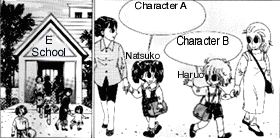|
|
EFL
Japan "a world of difference" |
Pragmatics and American Conversational Usage |
|
|
EFL
Japan "a world of difference" |
Pragmatics and American Conversational Usage |
and saying good-bye to a friend at school (game #8).
|
Game 8 |
||
| Conversational Focus Today's classes are over, and Haruo and Natsuko are leaving with their mothers ... 今日のクラスが終わり、ハルオとナツコはそれぞれお迎えに来たお母さんと家に帰る。 |
Communication Function CharacterA / CharacterB Saying goodbye to a friend (at school) (学校の)友達にさようならを言う。 |
Character A / Character B 1. Bye-bye. /Bye-bye. |
 What would you say? |
||
3. Using a pic-word format allows you to
use these materials at virtually EVERY level of proficiency.
The clarity of the situation produced a much greater
awareness and sensitivity in learners to the fact that changing
any one of several factors in each game could alter their responses.
Frankly, this result was an unexpected but delightful plus in
using these materials. The false beginner didn't need extensive
written instructions. S/he could jump into the games, instantly
recognizing the social settings. The advanced learner was able
to discover new and useful expressions and gain new insights into
the workings of the target language.
4. Stimu-Con games are of a manageable size,
allowing learners to incorporate them easily into larger, extended
conversations.
My experience has confirmed what common sense told
me: it's much easier to learn smaller blocks of acceptable American
English conversation, and then discover ways of incorporating
them into a more extended conversation. This eliminates the need
to learn lengthy scripts of dialogue whose rigidity makes them
unusable. And, since the learner understands the relationship
between the situation - in its entirety - and the language used,
s/he can more appropriately combine it into an extended conversational
context.
|
|
|
|
|
|
|